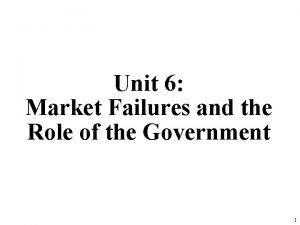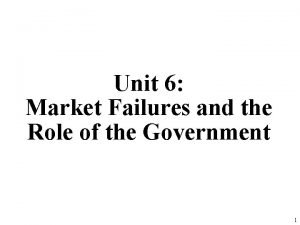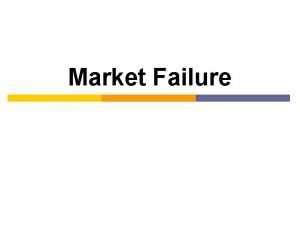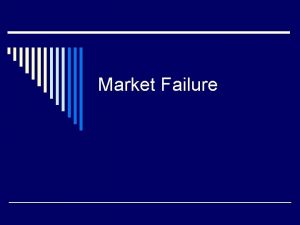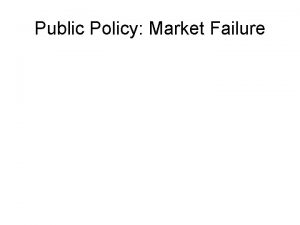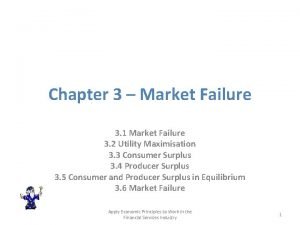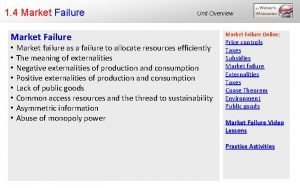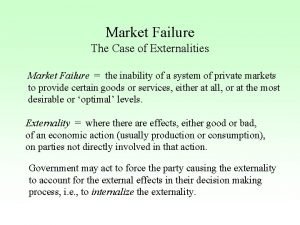Market Failure and the role of Government DR









- Slides: 9

Market Failure and the role of Government DR MD MASROOR ALAM ASSISTANT PROFESSOR DEPT OF ECONOMICS, CMB COLLEGE, DEORH, GHOGHARDIHA B. A Third year Eco H Public Economics

Market Failure: A Role for Government �A market failure occurs when the competitive market system (1) does not allocate any resources whatsoever to the production of certain goods, or (2) either underallocates or overallocates resources to the production of certain goods. �When private markets fail, government involvement may arise.

Private Goods �Private goods are those that people individually buy and consume and that private firms can profitably provide because they keep people who do not pay from receiving the benefits. �Two characteristics of private goods are: �Rivalry (in consumption) �Excludability

Efficient Allocation �Competition among firms to produce the private goods that consumers demand forces them to use the best technology and the right combination of productive resources. �This results in productive efficiency: the production of a good in the least cost way. �Firms that are not productively efficient face competition from lower cost firms.

Cont. . Competitive markets also produce allocative efficiency: the production of the “right” mix of products (minimum-cost production assumed). �Firms will produce goods and services that are highly valued by society ensuring that resources are allocate efficiently.

Public Goods �Public goods are those that everyone can simultaneously consume and from which no one can be excluded, even if they do not pay. �Two characteristics of public goods are: �Nonrivalry (in consumption) �Nonexcludability

Cont. . �Nonrivalry and nonexcludability create a free-rider problem; once a producer has provided a public good, everyone including nonpayers can obtain the benefit. �This makes it impossible for firms to gather resources and profitably provide the good. �In order to have the good, society must direct the government to provide it. Surveys and public votes may be used to determine the demand for a public good.

Comparing Marginal Benefit to Marginal Cost �Determining the “right” amount of a public good will depend on the marginal benefit and the marginal cost of providing it. �Marginal benefit (MB) is the added benefit or utility from the production of one more unit. �Marginal cost (MC) is the extra cost of producing one more unit. �The optimal quantity occurs when the MB equals the MC of the last good provided.

Externalities �An externality occurs when some of the costs or the benefits of a good are passed on to or “spill over to” someone other than the immediate buyer or seller. �Externalities can be positive or negative and can affect production or consumption.
 Role of government in correcting market failure
Role of government in correcting market failure Example of negative externality
Example of negative externality Unit 6 market failures and the role of the government
Unit 6 market failures and the role of the government Unit 6 four market failures
Unit 6 four market failures Failure to capture vs failure to sense ecg
Failure to capture vs failure to sense ecg Failure to sense pacemaker
Failure to sense pacemaker Ductile and brittle fracture
Ductile and brittle fracture Market segmentation target and positioning
Market segmentation target and positioning Market follower
Market follower Define market failures
Define market failures


